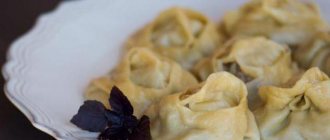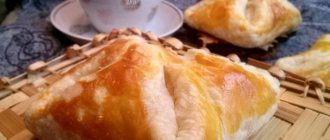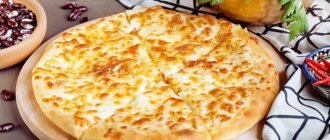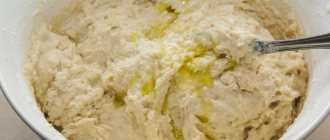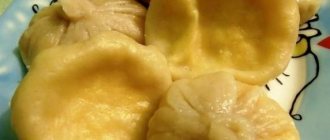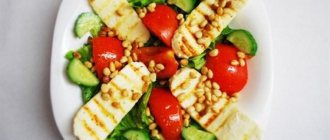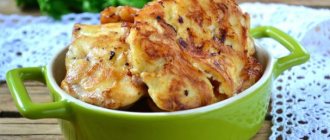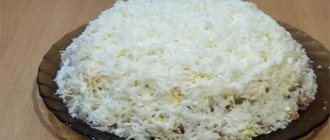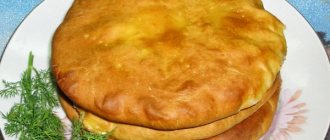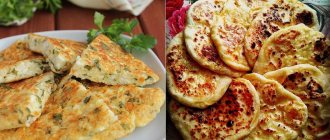The literal translation of the word “khachapuri” from Georgian is “bread with cheese.” More precisely, this dish is a flatbread with cheese as a filling. Each region of Georgia prepares khachapuri in its own way. They differ from each other not only in shape, but also in the method of preparation and the use of different cheeses. This dish is one of the few for which the country has filed a patent. Now only flatbreads with cheese produced on Georgian territory can be called khachapuri.
What is it confused with?
Lobiani – flatbread with spicy beans. In terms of popularity, lobiani is in no way inferior to khachapuri. Even on December 17 (St. Barbara’s Day) this dish should be on the table of every Georgian!
Habisgini is a flatbread filled with cheese and potatoes in equal proportions. The potatoes are boiled, peeled and passed through a meat grinder. This mass is then mixed with cheese and a couple of raw eggs. This mixture is used as a filling. Habisgini is very large in size and the dough is rolled out thin.
Kubdari or Svan khachapuri - “meat pie”.
An original Svan dish, the filling of which is chopped meat baked in dough. It is the “highlight of the program” at weddings in those places.
How to eat acharuli correctly
They say that visitors and tourists who try acharuli for the first time are immediately visible. In order not to stand out too much from the locals and “experienced” tourists, you will definitely have to give up the fork and knife. The flatbread is eaten exclusively with your hands. If desired, wash it down with tea, tarragon or lemonade.
To begin, break off the tail (as seen in the photo), mix the cheese-egg-cream filling into it and put a piece of bread in your mouth. Next, moving along the edge, they break off the side piece by piece, dip it in the rich mixture and eat it. The remaining bottom is rolled into a tube and eaten last.
Cheese khachapuri is the soul of Georgia! They are used for breakfast, lunch, dinner, treated to guests and served at weddings. They are eaten independently and in combination with other dishes. The national dish is baked and sold in any region of the hospitable country. The most unusual and sophisticated are acharuli. The second ones are Imeretian. The best option is to go to Georgia (the homeland of khachapuri) and make your own rating of tastes. And upon your return, be sure to learn how to make delicious cottage cheese bread with your own hands!
What cheese to add
Many people love suluguni, so they add it almost everywhere in large quantities. Perhaps because this cheese stretches so deliciously. In addition, suluguni has a more stable quality - it is easier to store than Imeretian cheese.
Suluguni is a stretch cheese (during the production process the cheese is stretched, this gives it a characteristic fibrous structure), reminiscent of the preparation of mozzarella. The color of this cheese should not be boiling white; the normal shade of suluguni is gray-yellow, which means that all the fat has not been removed from the cheese. It is important to try it if you want to find good suluguni on the market. Usually, fresher cheese languishes in a bucket of brine. If the suluguni is not sold on the first or second day, then it is transferred to polyethylene. This is how the seller adjusts the salt level.
Imereti cheese is the basis for suluguni. This unaged cheese resembles cottage cheese, especially when pureed. It is also more fresh and tender compared to suluguni. Imereti cheese should be neither bland nor over-salted. But you never know how it will behave after heat treatment.
Megruli
According to an ancient Caucasian legend, megruli was invented by housewives when they were trying to give traditional khachapuri a richer and more delicate taste. For this, the following trick was invented: cheese was used not only as a filling, but it was also sprinkled on top of the pie. The fried dairy product acquired a pleasant aroma and had a reddish tint, which made the dish more beautiful. Traditionally, meghruli is prepared in a clay frying pan.
In Megrelian
Megrelian or in other words - Megruli khachapuri are distinguished by a more festive appearance and a long preparation process. Such khachapuri are prepared in a large oven or oven, for the whole family at once. It has two layers of cheese: one in the center and one on top. If you are in Megrelia, do not miss the opportunity to try such delicious pastries. Unlike Imeretian khachapuri, Mingrelian khachapuri cannot be bought on the street; their preparation process is lengthy and must be eaten hot.
Many dishes were created in Megrelia, not only the above-mentioned khachapuri, but also food with walnuts, suluguni, satsivi, and adjika come from there. Unusual suluguni cheese is placed in the filling of the flatbread. When baking, the cheese begins to melt and stretch into beautiful threads.
Ingredients for making dough:
- flour - 500 g;
- warm water;
- butter - 2-3 tablespoons;
- yeast - 1 tablespoon;
- salt - 1 teaspoon.
Ingredients for preparing the filling:
- suluguni - 400 g;
- egg - 1 piece.
- cheese - 100 g;
Components for preparing the top layer of sprinkles:
- butter - 2 tablespoons;
- yolk - 1 piece.
Cooking process:
- To prepare the dough, you need to dilute the yeast in warm water. Add a little flour to it and make a batter. The flour needs to be sifted. Place the dough in a warm place for 40-50 minutes to rise. If there is not enough time, then you need to immediately proceed to the next stage.
- Add flour to the dough and knead into a soft dough. Add butter and mix with it. Cover the dough with plastic and place in a warm place to rise for 40 minutes.
- The finished dough should be rolled out into a flat cake, 1.5 cm thick, the size of a baking dish.
- For the filling, mix grated cheese and egg. If the cheese is lightly salted, then you need to add salt.
- Place the filling in the center, pinch the edges of the flatbread on top. Then the cake needs to be given its original appearance, stretching it to its previous size.
- Turn the khachapuri seam side down and roll out with a rolling pin.
- Heat the stove to a temperature of 200 degrees.
- Place the flatbread in the mold and sprinkle grated cheese on top, mixed with yolk and butter.
- Bake for 15 minutes until golden brown.
Georgian classic recipe
You bite into a hot, crispy flatbread, and behind the piece is a delicious string of cheese. It's much better than pizza! After all, it is in these flatbreads that so much filling is placed so that you appreciate the pleasant, slightly salty, pleasant taste, coupled with the fresh bready aroma of the outer ruddy shell.
And when this edible delight has cooled down a little, you can safely cut it into pieces or, better yet, tear off the tender edges with your hands.
Typically, Georgian housewives prepare and serve hot flatbreads to the table in large quantities. But for yourself, you can prepare only 1-5 pieces, reducing or increasing the proportions of ingredients or the size of the product. This recipe provides the composition for preparing three products with a diameter of 25 cm.
We will need:
- Flour – 900 gr.
- Suluguni – 900 gr.
- Milk – 500 ml.
- Sunflower oil – 100 ml. + 1 tbsp. l.
- Dry yeast – 11 gr.
- Egg – 2 pcs.
- Sour cream – 2 tbsp. l.
- Potato starch, sugar - 1 tbsp. l.
- Salt – 1 tsp.
Preparation:
- As with any yeast dough, you should first prepare the dough. Heat the milk slightly so that the dry yeast with salt and sugar easily dissolves in it and begins its action. Be sure to add a glass of flour so that in a quarter of an hour in a warm place the mixture will increase in volume and you will get a kind of slightly foaming alum.
- Don't forget to sift the flour so that it is saturated with oxygen, and the result is an airy dough!
- Break one fresh egg at room temperature into the dough and add starch. Mix well to form a homogeneous, jelly-like yeast starter.
- Add the rest of the flour in parts and gradually knead the dough. Pour in oil (100 ml) and thoroughly knead into an elastic, soft ball that does not stick to your hands. Flatten it slightly and leave it for an hour and a half in a deep cup until it doubles in volume.
- By the time the dough has finished proofing, prepare the mixture for greasing the flatbreads: in a small cup, combine butter (1 tbsp) with sour cream and egg.
- Using a fork or whisk, bring this mixture until smooth.
- In order for the filling to melt well, it is best to turn the entire piece of suluguni into shavings using a grater.
- Lightly knead the dough and divide it into 3 equal parts. Roll each of them into round shapes of the same thickness, no more than half a centimeter thick.
- Distribute 250 grams in the center of each piece. grated curls, leaving at least 3 centimeters of empty edges, which we will need for further shaping of the products.
- If you lubricate your hands and rolling pin with sunflower oil, you will not need to add flour when rolling.
- If you still have little experience in sculpting khachapuri, then you can collect the edges in the form of a bag. Excess “waves above the knot” should be pinched off so that the center remains well sealed.
- Ideally, you should mold the edges of the cake so that they are tightly connected and there is no thick lump in the center. This skill will definitely come with experience.
- Lightly powder the joint so that it does not come apart during rolling, and slam it down a little with your hand.
- Roll the rolling pin several times, turn it over and pass it over the dough again so that our lump again takes the shape of a flat cake about 1 cm thick.
- Then carefully transfer this filled workpiece to a wide, oiled cast-iron frying pan or to a baking sheet covered with parchment. Generously grease the top with sour cream and egg mixture, which will then give the baked goods a golden brown color.
- Distribute the remaining grated chips evenly over the surface of each of the three workpieces. You don’t need to sprinkle it too close to the edges, so that when the suluguni melts, it doesn’t leak onto the hot dishes and burn.
- Place in an oven preheated to 180 degrees for about 20-30 minutes until a beautiful golden brown crust appears.
Khachapuri is simply great when it's hot, but you should still let it cool for at least 5 minutes so that the eaters don't get burned.
Adjarian boat
It is believed that sailors were treated to this boat-shaped khachapuri when they stepped ashore. Georgians love to tell beautiful stories at the table, but I want to believe this legend - the proximity of the sea justified the shape of acharuli (khachapuri in Adjarian). By the way, on the other side of the Black Sea there is a similar-shaped Turkish flatbread called pide.
Khachapuri in Adjarian style is a solitary gastronomic experience; it is inconvenient to share this dish with anyone. Inside is a mixture of Imeretian cheese and suluguni; before serving, add a raw egg and a little butter. It is customary to eat this khachapuri with your hands, breaking off the edge of the bread and dipping it into the filling.
Tap the dough with your finger, the sound should be dull, which means the acharuli is baked well. Sometimes the excess dough is scraped off around the perimeter during cooking, leaving only the crispy crust and filling. Some guests even hold the khachapuri up to the light to see how thin its walls are.
Recipe for Khachapuri in Adjarian style
Cooking time: 90 min
Number of servings: 1
Ingredients (for 1 Khachapuri):
- 200 grams of ready-made dough (you can see the recipe for homemade dough in the recipe below)
- Grated cheese – 180 g
- 3 chicken eggs
- Butter – 20 g
Recipe:
- Roll out a piece of dough so that it takes a round shape.
2. Fold the edges so that the dough takes the shape of a boat.
3. Crack 1 egg inside the boat and stir it with a fork to coat the entire inner surface with the egg.
4. Mix grated cheese with 1 egg and fill the dough boat with it.
5. Bake Khachapuri in an oven preheated to 200°C for 10 minutes. Remove Khachapuri from the oven, use a fork to make a hole in the center of the pie and break an egg into it. Place in the oven for another 5 minutes to allow the egg white to curl.
6. After 5 minutes, remove Khachapuri from the oven and place a piece of butter in the center.
Gurian (Gwezel)
They are interesting because hard-boiled eggs, cut into slices or in half, are placed inside along with the cheese. When cooking, the flatbread with cheese is folded in half and rolled into a kind of bagel.
Sometimes other similar dishes are mistakenly classified as khachapuri, but in fact these are already separate types of baked goods.
Lobiani . These are flatbreads filled with spicy beans. Sometimes it is called a variety of Racha khachapuri.
Khabisgini (Ossetian “khachapuri”) – thin and large-diameter flatbreads stuffed with potato, cheese and eggs.
Kubdari (Svanese “khachapuri”) is a flatbread stuffed with minced meat.
Achma is a multi-layer pie filled with salted cheese. The main secret of the dough is that before forming the pie, the rolled out layers, except for the bottom and top, are boiled in salt water.
It is obvious that Georgian cuisine is rich in different types of khachapuri. Every corner of Georgia has its own view. Although the main ingredients remain the same, the cooking methods and technology have undergone some evolution. Such changes, of course, do not harm the diversity of khachapuri types; on the contrary, their recipes become more original and are constantly being improved.
Varieties of khachapuri
Georgia is divided into several historical regions (Imereti, Megrelia, Adjara, Svaneti, Guria, Racha and so on). In each of them, khachapuri is prepared according to its own “special” recipe. In some areas they carefully preserve ancient recipes, in others they do not stop there and come up with new ideas. Still others manage to combine both options.
Reference! The most classic ones are considered to be Imeretian, Mingrelian and Adjarian.
Below are the most famous products of the country with photos.
Imereti (imeruli) is the simplest, most widespread and famous. It has a round shape corresponding to the size of the pan in which it is baked. It is a closed pie with cheese.
Megrelian (Megruli). Similar to the previous one, but with the addition of cheese sprinkled on top of the outside. Baked in ovens or ovens.
Gurian (guruli) has the shape of a crescent or cheburek. It is customary to add chopped boiled eggs to the cheese.
Adjarian (acharuli, ajaruli), sometimes called "boat". The shapes range from rough (home) to very elegant (restaurant). An open version filled with cheese, eggs and butter, usually baked in wood-burning ovens.
Rachuli - works from the highland region of Racha. They are square “envelopes” brushed with egg yolk on top.
Penovani is a recent invention, a favorite local fast food, puff khachapuri shaped like a square or triangle. Sold in every bread kiosk, penovani was enjoyed by the local population and guests of the country.
On a skewer
Speaking about what kind of khachapuri there are, we cannot fail to mention this type of traditional pastry. The dish cooked on a skewer has a rich flavor spectrum and rich aroma. To prepare baked goods, suluguni cheese is strung on a metal skewer and then wrapped in dough. During the frying process, the dough is saturated with cheese and the aroma of smoldering coals. A worthy answer to traditional kebab!
A little history
The national Georgian dish acquired its name from the words “khacho” and “puri”, which translated into Russian means “cheese, cottage cheese” and “dough, bread”. For the first time, flour products began to be prepared in the 13th-14th centuries in the northwestern region of Georgia, which was called Megrelia. Over time, many different varieties of cheese pastries have appeared. In the Middle Ages, Georgian-style khachapuri with cheese was a favorite dish of many sultans and even Russian princes.
Based on lavash
This dish is reminiscent of khachapuri, and is prepared very quickly. Thin sheets of Armenian lavash can be purchased at any chain store. You can take any cheese: Imeretian, Suluguni, pickled, hard.
Components:
- thin pita bread - 1 pack;
- butter - 60 g;
- sour cream or thick yogurt - 0.5 cups;
- egg - 1 piece;
- cheese - 400 g;
- salt.
Preparation:
- Grate the cheese on a coarse grater.
- Mix sour cream or yogurt with egg.
- Preheat the oven to 180 degrees.
- Place the first sheet of lavash in the mold, grease it with butter, sprinkle with cheese, and add the egg-sour cream mixture.
- Alternate layers until you run out of ingredients.
- Bake in the oven for 15 minutes.
- Grease hot pastries with butter.
- Cool, cut into squares.
Lush, delicious khachapuri with cheese made from yeast dough
Ingredients (for dough):
- Wheat flour – 1 kg.
- Chicken egg – 4 pcs.
- Sugar – 2 tbsp. l.
- Dry yeast – 10 gr.
- Milk – 2 tbsp.
- Butter – 2-3 tbsp. l.
- Salt.
Ingredients (for filling):
- Chicken egg – 3 pcs.
- Butter – 2 tbsp. l.
- Sour cream – 200 gr.
- “Suluguni” (cheese) – 0.5-0.7 kg.
Algorithm of actions:
- The main thing is to prepare the dough correctly. To do this, heat the milk (until warm). Add salt and sugar, yeast, eggs, flour.
- Knead, add oil towards the end. Leave for a while, 2 hours is enough for proofing. Don't forget to knead the dough as it increases in volume.
- For the filling: grate the cheese, add sour cream, eggs, melted butter, stir.
- Divide the dough into pieces (about 10-11 pieces). Roll out each one, put the filling in the center, bring the edges towards the middle, pinch. Turn the flatbread over to the other side and roll it out so that it is 1 cm thick.
- Grease the baking sheets with oil and bake (temperature 220 degrees). As soon as the khachapuri is browned, you can take it out.
- All that remains is to grease them with oil, call your family, and watch how quickly this work of culinary art disappears from the plate!
Penovani
Penovani (ფენოვანი) is one of the varieties of traditional Georgian khachapuri, the type is closer not to flatbreads, but to puff pastries. It is prepared from puff pastry without yeast; Imeretian cheese, suluguni or a mixture of both are used as filling.
The word “foam” in Georgian means “layer”, hence the name foamani, that is, “layered”. Like other types of Georgian khachapuri, this type of pastry is very tasty, especially when hot, piping hot. The dough is flaky and crumbly, and the cheese filling is aromatic and stretches very tasty.
The foaming recipe cannot be called simple, since you have to spend time preparing yeast-free puff pastry. Of course, you can buy a package of ready-made dough in the store, but homemade is much tastier.
Recipe
Ingredients
For puff pastry:
- Flour – 3-3.5 cups
- Water – 1 glass
- Butter (in dough) – 1-1.5 tbsp.
- Vinegar 6% – 1 tsp.
- Salt – 0.5 tsp.
- Butter (for layering) – 100 g
- Egg yolk (for greasing) – 1 pc.
For filling:
- Suluguni cheese – 200 g
- Egg white – 1 pc.
- Glass = 200 ml
Recipe:
- To make the foam, prepare the ingredients according to the recipe list.
- Combine cold water, melted butter, salt and vinegar.
- Add flour.
- First mix all the ingredients simply with a fork or spatula.
- Then knead by hand into a thick, elastic dough.
- Divide the dough into four equal parts. Roll out each piece of dough on a floured surface one at a time into a thin layer 2 mm thick.
- Lightly grease the entire surface of the dough with soft (softened at room temperature) butter.
- Roll out the remaining three pieces of dough in the same way, grease with oil and place on top of each other. It is convenient to transfer thin dough by throwing it on a rolling pin.
- Roll the resulting stack of dough layers into a tube/roll, wrap in film and place in the refrigerator for at least one hour. This is necessary for the butter to harden.
- Divide the egg into white and yolk; the yolk will be used for greasing the pies before baking.
- For the filling, grate the cheese, add raw protein and mix. I think that protein in the filling is not important, it’s just that there’s nowhere else to put it...
- Cut the finished chilled dough into six pieces. It is possible for a different number of blanks, it depends on the desired size of the foam or on the convenience of laying out their blanks on a baking sheet. It’s convenient for me to prepare portioned foams to fit the size of a pie plate...
- Each piece of dough must be carefully rolled into a square piece. It is highly advisable to preserve the layers! Place a portion of cheese filling in the center.
- Pinch the edges of the dough, giving the foam piece an envelope shape.
- Brush the puff khachapuri pieces with yolk and place in a preheated oven. Sometimes I make punctures with a fork to allow steam to escape, sometimes I don’t... It’s at your discretion. The dough rises above the boiling filling, and then falls after the oven, but it may tear a little.
- Bake at 200 degrees until golden brown (about 20 minutes, but the time depends on the properties of your oven).
Penovani with cheese is hearty, appetizing, delicious served immediately hot or warm, and then served cold. I sometimes cook them for breakfast, or as a snack for my daughter at school or on the road when traveling.
How are they different from each other?
Imerta khachapuri is the most famous type of Georgian delicacy. Every Georgian who knows how to cook “imeruli” can easily please a guest. The dough is “stuffed” with cheese filling and rolled out very thin. A simple round flatbread.
Marl khachapuri is identical in shape to Imerti khachapuri, but what makes them different is the presence of a second layer of dough on the surface of the “merguli”.
Gurian is prepared in the shape of a crescent. In addition to the usual ingredients, a chopped boiled egg is added to the filling. Every year it is served on the Georgian Christmas table.
Adjarian khachapuri is the calling card of Adjara. It has an oblong shape, which is why it is sometimes called a “boat”. At the end of cooking, pour an egg into the center. Traditionally, Adjarian khachapuri is eaten with your hands, breaking off pieces of dough and dipping them into the filling.
Rachuli. This dish comes from Racha, a highland region of Georgia. It has a square shape and is coated with egg yolk on the outside.
Georgian lasagna or “achma” is one of the most complex and delicious Georgian casseroles. It is a dish made from thin layers of dough soaked in cheese and butter.
Well, the most famous khachapuri is penovani, or puff khachapuri. Walking around Georgia, you can find it in almost any eatery. Mostly it has the shape of an envelope, but sometimes triangular foams are also found.
The most popular bread products of Transcaucasia were described above. If you still have any questions, come to Georgia!
What other ones are there?
- Achma is khachapuri made from puff pastry with a lot of suluguni and butter, reminiscent of lasagna. The most tender khachapuri, but also the most high-calorie.
- Anyone who loves lobio (a bean appetizer - editor's note) will also love lobiani - a lean version of khachapuri without cheese with beans. It is important to find a balance so that the filling does not turn out too dry (it will be tasteless) or too liquid - the khachapuri will fall apart. There is also a non-lenten version of lobiani, when Racha ham is also added to the filling.
- Pkhlovani is called khachapuri with the addition of beet tops or spinach.
- Kubdari is a Svanetian version of khachapuri without cheese, but with meat. I recommend trying it at least once in Svaneti. Firstly, it is extremely difficult to replicate the cooking technology in Moscow. And secondly, food is also an atmosphere: it’s a special pleasure to eat delicious dishes in the mountains.
Khachapuri - whose dish
Delicious, cheesy flatbreads are loved and baked in Georgia and neighboring Armenia. A logical question: whose dish is khachapuri? Ethnographers (specialists who study the culture of a people) believe that its history originates in the mountains in northwestern Georgia.
In 2010, Sakpatenti (National Center for Intellectual Property of the State) began developing a bill protecting the brand name of a product. In the fall of 2011, the state of Georgia received a patent for khachapuri. Now the flour (cheese) product is a national brand.
Variety of types and tastes
Khachapuri, as a national dish, has been an officially patented Georgian brand for several years. Each region of Georgia has its own unique khachapuri recipes. Every Georgian housewife has to knead the dough for this dish almost every day. Khachapuri is traditionally baked by women. But men are often familiar with the peculiarities of preparing this national dish.
It is noteworthy that khachapuri has been included in the UNESCO list since January 2019 and is an intangible cultural heritage of Georgia. The patent for the dish was issued in 2011. Georgians are passionate about their national dish. If you are traveling to Georgia, you should find out exactly how to properly eat different types of khachapuri.
The main rule for preparing khachapuri is to use the same amount of dough and cheese. In this case, you can get an amazing and memorable taste. The combination of different cheeses and dough is an endless basis for creativity, and yet there are certain traditions of how to cook and how to eat khachapuri.
Lazy khachapuri in a slow cooker
Multicookers have become an incredibly popular kitchen device, and sometimes in dachas they have already been able to replace traditional kitchen appliances, because in one small device you can fry, cook and even bake. And if we talk about a recipe for lazy khachapuri, then the laziest one would be the recipe made from thin pita bread in a slow cooker.
- Thin lavash 2 pcs
- Sunflower oil 1 tbsp
- Milk 1.5 tbsp
- Hard cheese 300 g
- Egg 2 pcs
Steps
- As for any recipe for this cheese and flour product, you need to break the eggs and beat them a little. Then add grated cheese to the eggs and stir so that the eggs are distributed evenly between the cheese. Now pour milk into this mixture.
- Cut the pita bread into squares so that they cover the bottom of the multicooker bowl completely, and the corners extend to the sides. Place the first sheet on the bottom of a greased bowl. Pour some filling over it. We continue the procedure until the layers of lavash are finished; if the filling remains, then pour it completely onto the top layer.
- On the multicooker panel, set the “baking” mode and set the time to 45 minutes. After cooking is complete, lift the lid and let stand for another 3 minutes, then turn the finished dish onto a serving plate.
Khachapuri with lavash cheese
If you have too little time to knead the dough, you can try making khachapuri using thin pita bread.
Of course, it cannot be called a full-fledged Georgian dish, especially if the lavash is Armenian; on the other hand, the taste of this dish will definitely be rated ten points by the family.
Ingredients:
- Lavash (thin, large) – 2 sheets.
- Chicken egg – 2 pcs.
- Smoked sausage cheese (or traditional “Suluguni”) – 200 gr.
- Cottage cheese – 250 gr.
- Kefir – 250 gr.
- Salt (to taste).
- Butter (for greasing the baking sheet) – 2-3 tablespoons.
Algorithm of actions:
- Beat kefir with eggs (fork or mixer). Place part of the mixture in a separate container.
- Salt the cottage cheese and grind. Grate the cheese and mix with cottage cheese.
- Grease a baking sheet with oil, place 1 sheet of pita bread, so that half remains outside the baking sheet.
- Tear the second pita bread into large pieces and divide into three parts. Moisten 1 part of the pieces in the egg-kefir mixture and place on pita bread.
- Then distribute half of the cheese and curd mass evenly over the surface. Place another portion of the lavash pieces, moistening them in the egg-kefir mixture.
- Again a layer of cottage cheese with cheese, finish with a third piece of lavash torn into pieces, again dipped in kefir and egg.
- Pick up the sides, cover the khachapuri with the remaining part of the pita bread.
- Lubricate the surface of the product with the egg-kefir mixture (set aside at the very beginning).
- Bake in the oven for 25-30 minutes, temperature 220 degrees.
- “Khachapuri” will turn out to be huge, covering the entire baking sheet, ruddy, aromatic and very tender!
